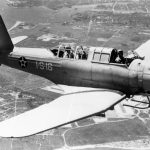
Pratt & Whitney’s J57 engine is a twin-spool, axial flow turbojet engine with standard and afterburning configuration. The J57 was the first turbojet design for the company and represented a technological leap in the field of jet engine design which was well received and truly revolutionized air travel when introduced in the early 1950s. In fact, it was so well received it won the prestigious Collier Trophy for the greatest achievement in American aviation in 1952.
Tinker has a long history with the J57 engine since it is has powered or continues to power major aircraft systems maintained here including the KC-135 Stratotanker and B-52 Stratofortress. This long association was formalized when on July 1, 1963 the Oklahoma City Air Materiel Area became the single overhaul site for J57 engines within the Air Force, according to official Tinker history documents. In 1967 KC-135s and B-52s are put on contract at Tinker’s OC-AMA which resulted in an entirely new production line in Bldg. 3001, and more overhaul work of J57s.
On June 30, 1969 OC-AMA began to manage the entire item line for J57. Work on J57 powered KC-135s came to an end on Sept. 29, 1995 when the last J57-59W engine was pulled from a KC-135Q. The majority of the C/KC-135 fleet were upgraded to CFM56 high-bypass engines. However, the story for the J57 engine continues at Tinker with on-going work for the B-52 Stratofortress and special mission aircraft such as the OC-135 ‘Open Skies’ jet.
According to a Pratt & Whitney fact sheet on the J57, the engine was the preferred powerplant for almost every aircraft manufacturer building high-performance aircraft in the 1950s. This included not just jet fighters like the Century Series jets for the Air Force in the form of the F-100, F-101, F-102, and prototype F-105, but also carrier based jets for the Navy such as the F-8, A3D, F4D, and F5D. Larger military aircraft such as the B-57D, B-52, KC-135, C-137, were also powered by the J57. The commercial version, the JT3, powered highly successful designs by Boeing on the 707-120 and 720 and McDonnell Douglas DC-8-10 airliners.
In commercial aviation the JT3 is beloved since it truly opened up air travel to the masses in the jet age by dramatically increasing the speed of, in particular, trans-Atlantic flights. Four JT3s powered the popular Pan American World Airways Boeing 707s from New York to Paris at a cruising speed of 575 mph. This is 225 mph faster than the newest propeller-driven airliner of the time, according to P&W.
For the U.S. military, the J57 engine played a particularly important role during the Cuban Missile Crisis of 1962. The Air Force’s high-altitude U-2 reconnaissance aircraft which first discovered the presence of Soviet missile sites 90 miles from the continental United States in Cuba were powered in to the stratosphere by the J57. As the crisis intensified many units were put in to a higher alert status as they played major or supporting roles in military operations teetering on the brink of war. J57 powered KC-135 Stratotankers refueled B-52 Stratofortress bombers along with the premier fighters of the day as they conducted Cold War training missions. All were powered by J57s. Navy F-8 Crusaders using J57s launched from carriers and shore-based airfields.
Initial proof of the missiles’ presence was obtained by the U-2s. Additional photographic proof, many of which were released to the public to make the case of Soviet aggression were taken by RF-101 ‘Voodoo’ tactical reconnaissance jets powered by twin J57s. One particular photo is famous for showing the Soviet transport ship docked with missiles clearly visible on the deck accompanied by the silhouette of the RF-101 which took the photo in the right corner. After the shoot down of a U-2 and subsequent top-secret negotiations to end the crisis, proof of the missiles withdrawal was obtained by J57 powered RF-101s.
The Cold War era engine has taken pilots through the speed of sound, to the edges of space and the brink of nuclear war, and continues to power the B-52 to this day in combat. Now in its 66th year of service, the J57 is the longest serving jet engine family ever.






























